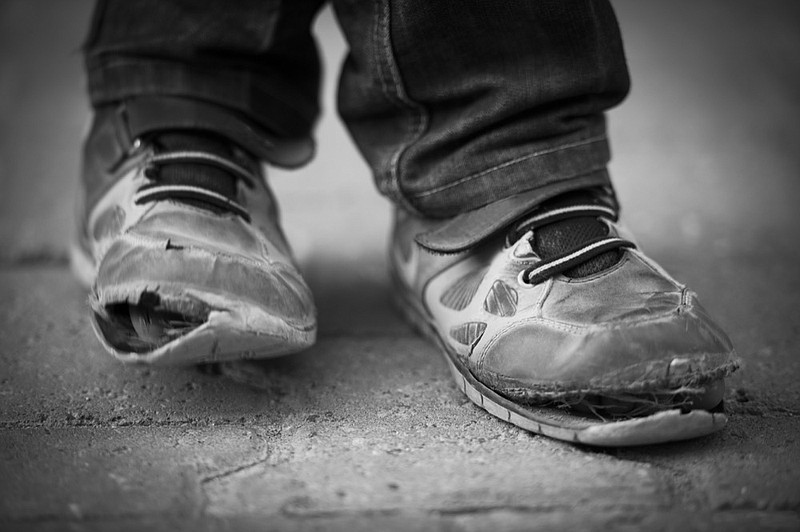NASHVILLE - The percentage of Tennessee and Georgia children living in areas of concentrated poverty and low opportunity fell 7% from 2013 to 2017, according to a new national study being released today.
According to the latest KIDS COUNT data snapshot from the Annie E. Casey Foundation, the number of Tennessee children "trapped" in impoverished communities with few job opportunities and stagnant wages fell by 15,000 to 200,000 in 2017 while in Georgia, 20,000 fewer kids now live in such circumstances. The new estimate pegs the total there at 225,000.
Alabama remained flat percentage-wise with 15% or 168,000 children living in poor communities, according to the report, titled "Children in High Poverty, Low-Opportunity Neighborhoods."
While Tennessee and Georgia numbers dropped, the respective totals in each of the states still are still high enough to exceed Chattanooga's total population.
In practical terms, 13% or nearly one out of every eight Tennessee children continue to face challenges because of where they live. For Georgia, it's also 13%.
Speaking nationally, the report says that although the U.S. remains "in the midst of a long period of economic expansion ... stagnant wages, rising housing costs and inaccessible job opportunities keep many children and families trapped in impoverished communities.
"And despite economic growth, we have not seen significant reduction in poverty," the report says.
Using the latest figures available from the U.S. Census Bureau, the snapshot looks at where concentrated poverty has worsened across the country despite an extended period of economic expansion nationally.
Experts say children living in neighborhoods with high levels of concentrated poverty are at risk not only from negative environmental exposure, reduced opportunities and higher rates of crime, but also face increased chronic stress and trauma.
Policies affect children
According to the Annie E. Casey Foundation, policies at the community, county and state level that can significantly impact the lives of children in struggling families include:* Supporting development and property-ownership models that preserve affordable housing, such as community land trusts and limited-equity cooperatives.* Ending housing discrimination based on whether a person was formerly incarcerated or is using a federal housing voucher.* Helping low-income residents with paying higher property taxes that often come with new development and redevelopment or with a family’s relocation to a more affluent area.* Expanding workforce training that is targeted to high-poverty, low-opportunity communities.* Incentivizing major employers, hospitals and universities to hire locally and contract with businesses owned by women and people of color.* Developing and funding small-business loan programs that serve entrepreneurs in low-income neighborhoods and communities of color — or people that traditional lenders tend to reject, such as individuals with poor credit or criminal records.Source: KIDS COUNT: Children in High Poverty, Low-Opportunity Neighborhoods
The Tennessee Commission on Children and Youth, the Tennessee KIDS COUNT affiliate, partners with other state and private agencies via the state's Building Strong Brains Tennessee strategy to help Tennesseans to respond to childhood adverse experiences.
"Our state's future relies on the stimulus we are giving the brains of its future wage earners though healthy nutrition and quality education," said Richard Kennedy, TCCY's executive director. "We need to make sure all of our children have the resources and opportunities they need to be successful."
Growing up in a community of concentrated poverty - defined as a neighborhood where 30% or more of the population is living in poverty - is one of the greatest risks to child development, officials say.
Nationally, more than 8.5 million children are living in such circumstances, almost 12% of all children living in the U.S. These children tend to lack access to healthy food and quality medical care, according to TCCY. And they often face greater exposure to environmental hazards, such as poor air quality as well as toxins such as lead.
From 2013 to 2017, the total number children in these communities fell by 817,000.
Financial hardships and fear of violence can cause chronic stress linked to diabetes, heart disease and stroke, officials say. And when they grow up, they're more likely to have lower incomes than children whose families were able to move away. Collectively, the conditions help foster an "environment of toxic stress," according to TCCY's Kennedy.
"Toxic stress affects the developing brain," Kennedy said. "Our youngest children are the most likely to live in low income households. We need to develop solutions to help families and their children live in safe communities and grow up healthy."
Kennedy also said Tennessee's state government has been "recognized as a national leader in fiscal stability and innovator in problem solving. Providing better training and work opportunities for families to assist them to rise out of poverty would help us prevent and mitigate the effects of these problems, increase community safety and prosperity and strengthen our state."
Contact Andy Sher at asher@timesfreepress.com or 615-255-0550. Follow on Twitter @AndySher1.
National findings
Key national findings from the Annie E. Casey’s latest snapshot’s 50-state states include:* Nationally urban areas have both the largest number and share of children living in concentrated poverty: 5.4 million, or 23 percent of all kids in cities. About 11 percent of kids (1.2 million) in rural areas live in poor communities, while 5 percent of suburban kids (2 million) do.* States in the South and West tend to have high rates of children living in concentrated poverty, making up 17 of 25 states with rates of 10 percent and above.* African American and American Indian children are seven times more likely to live in poor neighborhoods than white children, and Latino children are nearly five times more likely, largely as a result of legacies of racial and ethnic oppression, as well as present-day laws, practices and stereotypes that disproportionately affect people of color.Source: KIDS COUNT: “Children in High Poverty, Low-Opportunity Neighborhoods

